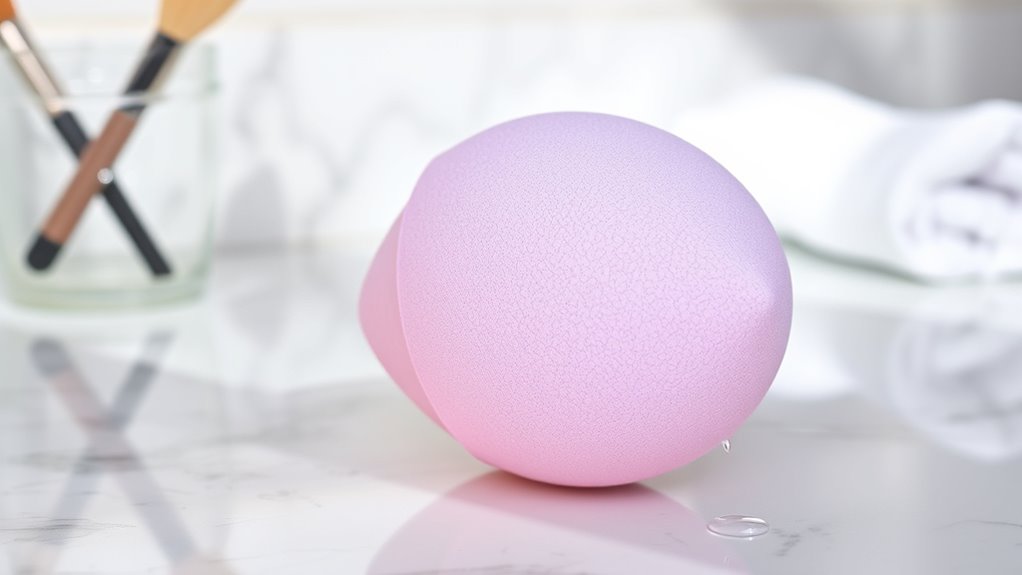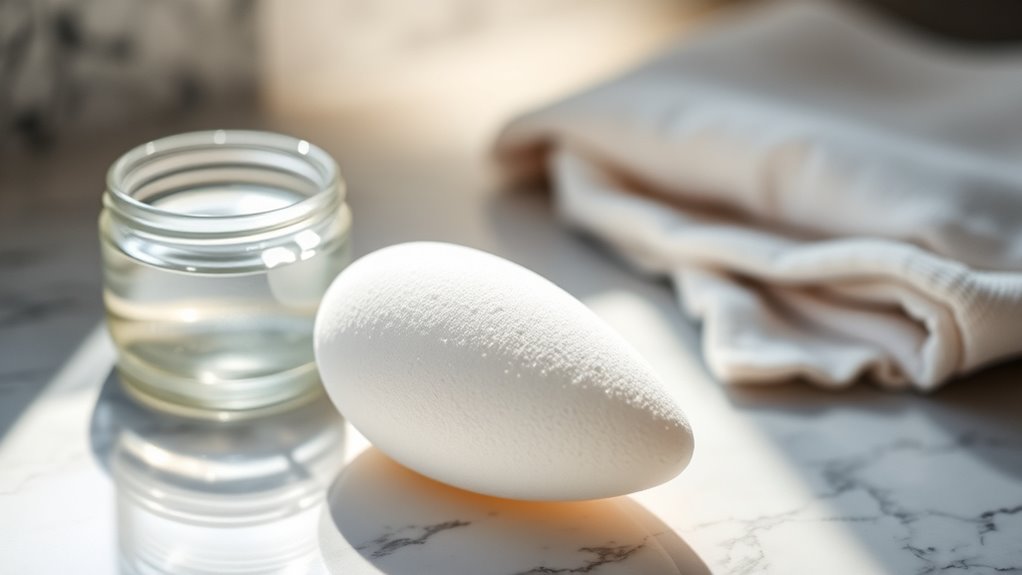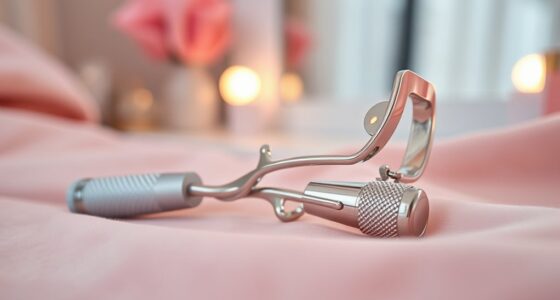To keep your makeup sponge clean and effective, wash it at least once a week with a gentle cleanser or sponge cleaner, making sure to rinse thoroughly until the water runs clear. Toss your sponge when it shows signs of wear, like persistent stains, a foul smell, mold, or if it becomes rough, frayed, or misshapen. If you want to maintain flawless makeup and healthy skin, understanding care tips is key—continue to explore for more details.
Key Takeaways
- Wash your sponge at least once weekly with gentle cleanser to remove buildup and maintain hygiene.
- Replace your sponge when it develops persistent stains, foul odor, or visible mold that won’t wash out.
- Discard the sponge if it becomes rough, frayed, cracked, or loses its shape to prevent uneven application.
- Properly dry the sponge after cleaning to prevent mold growth and bacteria buildup.
- Regular inspection and timely replacement ensure optimal makeup application and skin health.

Taking proper care of your makeup sponge is essential to guarantee it stays clean, lasts longer, and applies your makeup smoothly. You might think that simply rinsing it after use is enough, but regular cleaning and knowing when to replace it can make all the difference in your makeup game. Your sponge accumulates dirt, oil, bacteria, and leftover product with each use, which can lead to breakouts, skin irritation, or uneven application if not properly maintained. Consequently, establishing a routine for washing and understanding when it’s time to toss your sponge is key to maintaining healthy skin and flawless makeup application.
Proper sponge care ensures flawless makeup and healthy skin. Clean regularly and replace when needed.
You should wash your makeup sponge at least once a week if you use it daily. Regular cleaning removes built-up oils, dead skin cells, and residual product that can harbor bacteria. To do this effectively, soak your sponge in warm water with a gentle cleanser or a specially formulated sponge cleaner. Gently squeeze and massage the sponge to loosen dirt, then rinse thoroughly until the water runs clear. Avoid harsh soaps or scrubbing too aggressively, as this can damage the sponge’s material. After washing, squeeze out excess water and let it air dry in a well-ventilated space. Drying your sponge properly prevents mold and bacteria growth and keeps it in good condition for longer. Proper drying techniques are crucial for preventing bacteria buildup and extending the lifespan of your sponge.
There are signs that tell you it’s time to replace your sponge sooner rather than later. If your sponge develops persistent stains that won’t come out after multiple washes, it’s a clear indicator it’s reached its end. Additionally, if you notice any foul smell, mold, or a rough, frayed texture, it’s time to toss it. These issues can be signs of bacteria buildup or material degradation, which can pose risks to your skin. Also, if your sponge becomes noticeably misshapen, cracks, or loses its bouncy feel, it won’t provide the smooth, even application you want. Using a worn-out sponge can lead to uneven makeup, streaks, and potential skin irritation, so don’t hesitate to replace it when necessary.
Ultimately, listening to your sponge’s condition and maintaining a consistent cleaning routine will ensure it performs at its best. Proper care not only extends its lifespan but also protects your skin from bacteria and irritation. Remember, a clean sponge delivers a more polished, natural look and helps you avoid unnecessary breakouts. When your sponge starts showing signs of wear or no longer looks or smells fresh, it’s a clear sign to replace it. By taking these steps, you’ll enjoy a healthier complexion and consistently flawless makeup application every time.
Frequently Asked Questions
How Often Should I Replace My Makeup Sponge?
You should replace your makeup sponge every 3 to 4 weeks to prevent bacteria buildup and maintain hygiene. If you notice tears, tears, or a persistent bad smell, toss it sooner. Regularly washing your sponge helps extend its life, but over time, it gets worn out and less effective. Prioritize replacing it on schedule to ensure a clean, flawless makeup application and avoid skin breakouts.
Can I Use Household Cleaners to Disinfect My Sponge?
You can use household cleaners to disinfect your makeup sponge, but choose carefully. Ideally, use a gentle disinfectant like rubbing alcohol or diluted hydrogen peroxide, which effectively kills bacteria without damaging the sponge. Avoid harsh chemicals like bleach or strong disinfectants, as they can degrade the material. Always rinse thoroughly afterward and let the sponge air dry completely before next use to keep it clean and safe.
Is It Safe to Share Makeup Sponges With Friends?
Sharing makeup sponges with friends isn’t safe because it spreads bacteria, germs, and potential infections. You risk breakouts, skin irritation, or more serious issues. Instead, keep your sponges to yourself, wash them regularly, and replace them when they show signs of wear. Protect your skin and stay healthy by avoiding sharing, practicing good hygiene, and investing in quality tools. Your skin will thank you for the extra care.
How Do I Prevent My Sponge From Developing Mold?
To prevent your sponge from developing mold, you should keep it dry and clean. After each use, squeeze out excess water and let it air dry in a well-ventilated area. Avoid storing it in damp places like your bathroom cabinet. Regularly wash your sponge with soap and water, then thoroughly dry it. Replacing it every few months also helps prevent mold buildup and keeps your skin healthy.
What Are Signs My Sponge Is Beyond Cleaning?
Your sponge is beyond cleaning if it’s discolored, smells terrible, or feels slimy despite washing. If it’s lost its original shape or has visible mold, it’s time to toss it—these are signs it’s a health hazard. Don’t risk your skin’s health; replace it promptly. A dirty sponge can harbor bacteria that spreads faster than wildfire, making it essential to recognize when it’s no longer salvageable and get a new one.
Conclusion
Taking care of your makeup sponge is like tending to a delicate garden—regular cleaning keeps it fresh and thriving. Wash it when it looks dull or starts to smell, and toss it if it’s torn or no longer fluffy. By staying on top of sponge care, you’ll enjoy flawless makeup application every time. Think of your sponge as your beauty partner; treat it well, and it’ll reward you with perfect, smooth finishes every day.









